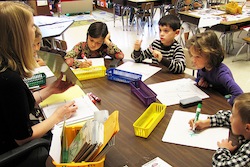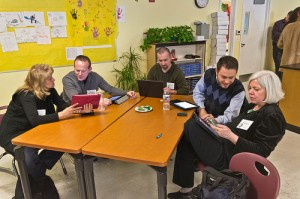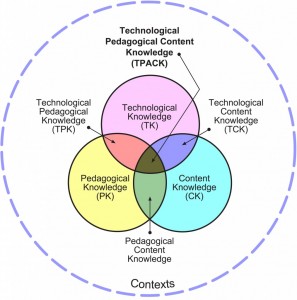One of the first books I read when I began preparing for a role in educational administration was Ten Traits of Highly Effective Teachers: How to Hire, Coach, and Mentor Successful Teachers by Elaine McEwan-Adkins. Published in 2001, the author concisely describes how the following qualities define great teachers, in terms of their character, skill-specific qualities, and intellectual traits:
- Mission-driven and passionate
- Positive and real
- A teacher-leader
- “With-it-ness”
- Style
- Motivational expertise
- Instructional effectiveness
- Book learning
- Street smarts
- A mental life
A fairly all-encompassing list. Applicable 10+ years later? I believe so. Kind of timeless, in a sense. The descriptors surrounding those qualities may evolve as does a teacher’s role each year.
I do a lot of thinking about teacher quality. I am able to interact with many teachers in both face-to-face and online settings each and every day. As some administrators may be able to tell you: Almost without fail, you can spot a quality teacher by simply existing in their presence for a few short minutes. There’s something about the way she interacts with students, is organized and prepared, is a fluid communicator and skillfully asks engaging questions, is capable of captivating an audience. He’s someone who has command of a learning environment, and it’s an absolute delight to watch this teaching and learning in action. A quality teacher has “with-it-ness,” as McEwan-Adkins describes.
The essentials of 21st century teaching
 Several weeks ago my colleague Steve Goldberg shared a post on his blog that was not about teacher quality, but instead focused on Interdisciplinary Reading. I couldn’t help but be impressed as I read through Steve’s depiction of how he would lead students in an interdisciplinary exploration of current events, by engaging them first with two paragraphs of online content from The New Yorker, questioning and probing with eventual references made to other sources such as the Mega Penny Project and Science Daily, then learning about the life of Wangari Maathai, using web-based conversion tools to find the number of acres in Germany, and finishing with a literary discussion surrounding Red Scarf Girl.
Several weeks ago my colleague Steve Goldberg shared a post on his blog that was not about teacher quality, but instead focused on Interdisciplinary Reading. I couldn’t help but be impressed as I read through Steve’s depiction of how he would lead students in an interdisciplinary exploration of current events, by engaging them first with two paragraphs of online content from The New Yorker, questioning and probing with eventual references made to other sources such as the Mega Penny Project and Science Daily, then learning about the life of Wangari Maathai, using web-based conversion tools to find the number of acres in Germany, and finishing with a literary discussion surrounding Red Scarf Girl.
Wow. All of that could emerge by reading just two paragraphs of content? It could. But my immediate push-back question to Steve was: How many teachers could support this journey? How many possess the necessary pedagogical and intellectual skill sets to do as you’ve described here, particularly with the fluid reference of online resources? As a result of some of our discussions in PLP, Steve began this Google doc brainstorming essential qualities of a “21st century educator.” Which of these skills do we see in our teachers today? In new teachers? Which are most desired, and why? (Feel free to add your thoughts to this document.)
Also consider the perspective of Mary Ann Reilly in her post Unpacking Common Core Standards. She sets the stage for her work with this introduction:
In order to better understand the middle school ELA Common Core State Standards, deconstructing the actions taken when engaging with a literary text can helpful. In this post, a series of performance and analysis tasks are explored and this is followed by examining the CCSS in order to see which of the standards were attended to. One of the ‘model’ texts included in the Common Core is William Butler Yeats’ poem, “The Song of Wandering Aengus.”
Visit Reilly’s post to see evidence of this task with supporting media, instructional strategies, technology integration, and details of student engagement. I am not a middle school administrator, so I do not know if what she describes is typical instruction at this level, but it seems to me that due to her vast content knowledge and ability to pull from a well-developed pedagogical base, she can skillfully embed technology to enhance learning, while ensuring the focus is on the learner and the desired outcomes.
Being able to plan for instruction in the manner that Reilly describes, and guiding students through a learning journey such as Steve depicts, are not skills that an average teacher will simply “pick up on” if, all of a sudden, we ask them to “learn about technology” in the traditional sense. Professional development where we bring in a Smartboard trainer or we teach faculty about specific tools will not lead to enduring understandings about teaching and learning.
Developing familiarity with the technology can be a great first step, yes. But a realization of how technology impacts student learning is a much larger issue than just deciding which web 2.0 tool is appropriate for use with a lesson. Do our teachers know what types of technology will enrich — or potentially detract from — content or the learning process, and why?
We need better professional learning models
Perhaps in our work designing professional learning opportunities for teachers, both in the pre-service stage and for those currently practicing, we need to consider models such as TPACK.
Ideally, we’d wish for our teachers to have a strong content knowledge base, be able to draw from extensive pedagogical knowledge, and have a deep understanding of technological knowledge that would allow for seamless integrations of technology appropriate to enhance both content and pedagogy. The complete teacher. More often:
– We encounter teachers who are wildly knowledgeable about their content area, but who lack desired pedagogical skills.
– Or we may find teachers who can implement strategies in the classroom and who have developed rapport and meaningful relationships with their students, but who lack the desired depth of content knowledge.
– Or we discover “techy” teachers who have an affinity for the latest tools and gadgets, who are networked in their own learning, but who can’t translate those skills to meaningful learning for their students because their knowledge of content and pedagogy are underdeveloped.
So we start pondering teacher qualifications, teacher preparation programs, teacher evaluation systems. We revisit Danielson and Marzano and Stronge. What are we asking new teachers to know and be able to do? Are their internship/student teaching experiences supporting their endeavors, or holding them back if they are placed in schools where “traditional” learning models are expected and enforced?
Asking hard questions about teacher development
Are we ensuring teachers are well-rounded in their knowledge bases? Are we making relationship-building with students, families, and colleagues a priority? Once they begin in their profession, how do we continually support teachers through the changes in educational practices, updates with technology, and shifts in curriculum that result? Are we asking teachers to be connected learners? Are the high-stakes teacher evaluation systems emerging in states across the country going to support administrators in boosting teacher quality? Or are they going to stifle us?
What can we do, as administrators, to promote teacher learning on a daily basis? How can we structure our organizations to allow for collaboration and communication among peers, embed opportunities for both face-to-face and online learning, help our teachers stay informed and familiar with current research and practices (in content, pedagogy, and technology), model for them that we ourselves are growing professionally, and help the organization as a whole realize that complacency must be eradicated?
How often are administrators and school leaders asking teachers (and ourselves): What’s one thing you wish you could learn more about? Learn it. What is one strategy you’d like to improve? Practice it. When is the last time you reflected upon something you did in your classroom with students? Plan to do it next week, and reflect continuously. When is the last time you asked your students what they needed you to be? Allow their passions and needs to influence your work together.
For all of us, the time to step outside of our comfort zones is now.
It’s time to learn like never before.
Photos – Creative Commons: Kevin Jarrett, WoodleyWonderworks
Lyn Hilt
Latest posts by Lyn Hilt (see all)
- User-Generated Learning: A Must-Do for School Leaders Today - January 15, 2013
- Lessons in 21st Century Leadership - April 27, 2012
- What Do We Need Our Teachers to Be? - March 2, 2012




Lyn,
This is an excellent post that should be shared with all educators because of the depth of reflective questions. I particularly like the last paragraph that provides key questions for teachers and admins.
Be Great,
Dwight
Thanks for reading, Dwight!
This was a very well written article. Perhaps someone will be willing to write a counter-article entitled, “What Do We Need Our Parents to Be?” My colleagues and I are more than willing to teach whatever content needs to be taught, whatever skills need to be polished, all the while being “with-it” and having “style, so kids do not get bored in our class – but somehow all of that other stuff – like dealing with a child who has their 5th case of lice and the parents refuse to pick him up from school; a child who for the last 6 days has worn the same clothes to school, and you know both parents are dealing drugs; teaching a 4th grader how to tie her shoes; monitoring a child with repeated trips to the nurse’s office with a toothache, but the parents have no health insurance, or both work in the city and just don’t have time to take their child for a visit to the dentist. I would be more than happy to be all of these things that people think I need to be in order to be a teacher, but life tends to get in the way and interfere with the learning/teaching that actually goes on! I am all for change, attend professional development course, webinars, college to obtain further degrees, but we are not the only cog in the wheel here. But with the public at times thinking like this, we wind up just spinning our wheels because ALL of the facets that go into the teaching of a child are not addressed.
Hi, Pat,
Thanks for sharing your comments. No one is pretending that the key to a child’s happiness and education lies with the teacher alone. It is quite tragic knowing what some children have to deal with in their family and personal lives, and it makes you feel helpless, doesn’t it?
I think the great gift of our profession is that we have the chance to be the person who makes a child’s day at school a memorable one – who makes school a welcoming, safe place to be – because, perhaps when they leave our doors, the reality of what’s waiting for them at home is not as pleasant.
And while as individuals it’s easy to blame external factors for a child’s struggles with learning (if only the parents would do this, if only the school would provide that), you have to keep in mind that you can control YOU, you can control your actions, and you can control how you choose to respond when faced with adversities.
If the children in our classrooms and lives are subjected to hardships, it is a time for us to rise up, strengthen our relationships with them, and give them the very best we can educationally.
Of course we’re not the only cog in the wheel, but we’re the ones with whom school-aged children get to spend most of their days. As difficult as it might be, we can’t play the blame game. We need to use the resources we have inside ourselves, within our teacher and school teams, and reach out to parents and community, in order to give each child what he deserves.
I’m with you that there needs to be a number of societal changes that need to occur to truly better the educational system as a whole. Poverty, equality in school funding, pre-natal and early childhood health- all of these things need to be improved in order to lead to better learning outcomes for kids.
Easier said than done? You bet. But once we start being more concerned about the general public’s perception of what a teacher can and should be than we are with the needs of the children that are standing in front of us each day, we lose focus.
And our kids can’t afford for their teachers to lose focus.
I am a retired secondary principal who was in the principalship trenches for 38 years. Needless to say I observed and worked with countless teachers to improve the quality of teaching and learning. Some of my conclusions regarding high quality classroom teaching follow:
1. The principal must be a visionary leader who gets staff on board to make the vision reality. When staff knows what their principal stands for they will respond with improved quality of teaching and learning in the classroom.
2. Staff must be taught the skills to excell in the classroom. The decisions they make regarding how they will teach must be conscious decisions. Again the principal is key in assuring stall that money will be available for staff training that will compliment making the vision reality.
3. Staff excitement about improving student learning will be accelerated when staff is empowered to make decisions about instructional approach. Quality instruction is directly correlated to staff attitude and excitment about what they are doing in the classroom.
4. Encourage staff to try innovative instructional approaches in the classroom and celebrate failure with the same enthusiasm as success.
Conclusion: Quality teaching results when teachers know the schools vision, know the skills of quality instruction, bring energy and unbounded enthusiasm to the classroom and they know their principal supports them without reservation.
Tom
DearLyn,I enjoyed reading your article and I have been a teacher for many years both in Britain and in the US too. I appreciate and can associate myself with all your views.